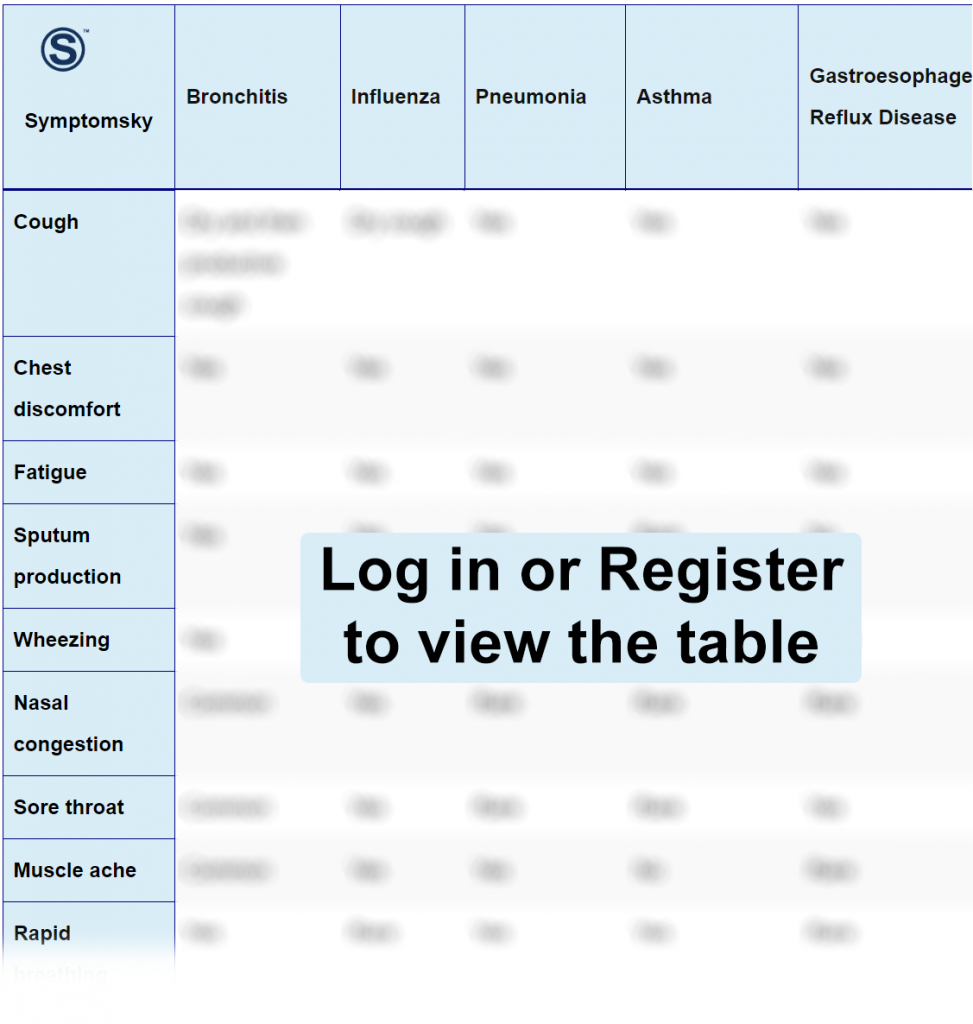Contents
- 1 Bronchitis Differential Diagnosis Table:
- 2 How to Distinguish Bronchitis from Other Diseases
- 2.1 How to Distinguish Influenza from Bronchitis – Diagnosis
- 2.2 How to Distinguish Pneumonia from Bronchitis – Diagnosis
- 2.3 How to Distinguish Asthma from Bronchitis – Diagnosis
- 2.4 How to Distinguish Gastroesophageal Reflux Disease from Bronchitis – Diagnosis
- 2.5 How to Distinguish Respiratory Syncytial Virus from Bronchitis – Diagnosis
- 2.6 How to Distinguish Bronchiectasis from Bronchitis – Diagnosis
- 2.7 How to Distinguish Heart Failure from Bronchitis – Diagnosis
- 2.8 How to Distinguish Lung Cancer from Bronchitis – Diagnosis
- 3 Common Red Flags with Bronchitis
Bronchitis Differential Diagnosis Table:

Bronchitis is a chronic disease that has a main characteristic: hypersecretion of mucus. It is defined as the presence of cough with expectoration; it can last from three months to a year, which means it can be confused with conditions with mutual symptomatology.
Risk factors: The risk factors involved in the etiology of this condition are clarified: smoking, air pollution, infections, family history, although these are not the only factors involved, there can be others such as hereditary prediction and social characteristics.
Clinical manifestations are usually confused or attributed to the cigarette, so they can go unnoticed:
Cough: Predominantly in the morning but as the disease progresses, the cough becomes more intense and occurs throughout the day.
Expectoration: Is white due to tobacco smoke but as it progresses becomes purulent greenish-yellow or it may contain blood as well.
Fever: There may be fever although it is not a very common symptom.
How to Distinguish Bronchitis from Other Diseases
How to Distinguish Influenza from Bronchitis – Diagnosis
Influenza is an acute seasonal viral disease.
- Influenza is characterized by fever, dry cough, headache, myalgia, sore throat, while bronchitis is characterized by chest soreness, wheezing, productive cough, and low-grade fever.
- Influenza affects mostly the upper respiratory tract, unlike bronchitis, which affects the lungs.
- Influenza, unlike Bronchitis, has a seasonal pattern.
- Bronchitis, unlike Influenza, can be caused by a bacterial agent.
How to Distinguish Pneumonia from Bronchitis – Diagnosis
Pneumonia is the inflammation of the pulmonary parenchyma.
- Pneumonia’s initial clinical presentation is characterized by a previous upper respiratory tract infection. The patient has intense chills, fever, general discomfort, cough with chest pain, while Bronchitis is characterized by chest soreness, wheezing, productive cough, and low-grade fever.
- Bronchitis is usually caused by a viral agent, while pneumonia is usually of bacterial origin.
- Bronchitis is an inflammation of the bronchi while pneumonia is an infection of the lungs.
How to Distinguish Asthma from Bronchitis – Diagnosis
Asthma is the most frequent chronic disease in children and adolescents.
- Asthma symptoms are wheezing, paroxysmal dyspnea, and cough with expectoration, while Bronchitis is characterized by chest soreness, wheezing, productive cough, and low-grade fever.
- Bronchitis is a condition that affects all the main branches of the pulmonary tree while in asthma, the entire respiratory tree is affected.
- Asthma is caused by different autoimmune mechanisms that generate inflammation of the respiratory tree while Bronchitis can be due to infections or exposures to toxic substances such as tobacco, chemicals, or irritants that generate chronic inflammation at the bronchial level.
How to Distinguish Gastroesophageal Reflux Disease from Bronchitis – Diagnosis
- Gastroesophageal Reflux Disease leads to respiratory clinical manifestations since gastric acid causes irritation and the body has defense mechanisms such as: coughing, apnea, sinusitis, otitis while Bronchitis is characterized by chest soreness, wheezing, productive cough, and low-grade fever.
How to Distinguish Respiratory Syncytial Virus from Bronchitis – Diagnosis
- Syncytial virus has catarrhal symptoms such as: sore throat, headache, fever, body aches, and runny nose while Bronchitis is characterized by chest soreness, wheezing, productive cough, and low-grade fever.
- The relationship between these two diseases is that syncytial virus can develop bronchitis.
How to Distinguish Bronchiectasis from Bronchitis – Diagnosis
Bronchiectasis is the dilation of the bronchi.
- Bronchiectasis is characterized by coughing and purulent and fetid expectoration while Bronchitis is characterized by chest soreness, wheezing, productive cough, and low-grade fever.
- During physical examination, bronchial rales will be heard. Patients with long data of evolution will have “drumsticks fingers” unlike Bronchitis where during auscultation, a whistle sound can be heard.
How to Distinguish Heart Failure from Bronchitis – Diagnosis
Heart failure is a condition in which the heart no longer pumps blood with oxygen around the entire body.
- Bronchitis belongs to chronic obstructive pulmonary diseases that are characterized by reduced airflow; this has a systemic effect, especially on heart function. They have similar symptoms such as: cough, dyspnea.
How to Distinguish Lung Cancer from Bronchitis – Diagnosis
Lung cancer is a tumor that affects the tissues of the lung.
- Lung cancer presents constitutional symptoms such as: loss of appetite and weight loss, while Bronchitis is characterized by chest soreness, wheezing, productive cough, and low-grade fever.
Common Red Flags with Bronchitis
It is important to know that bronchitis can be prevented by simply stopping smoking or quitting it, as well as avoiding pulmonary irritants such as: dust, vapors, and air pollution using the use of a mask. Patients with Bronchitis are usually smoking patients between the fifth and sixth decade of life. The onset of this disease is insidious.
Bronchial exacerbations are part of this disease; they are more prevalent during winter. Wheezing and dyspnea are present. Dyspnea may be due to emphysema or diffuse obstruction that the patient is coursing.
